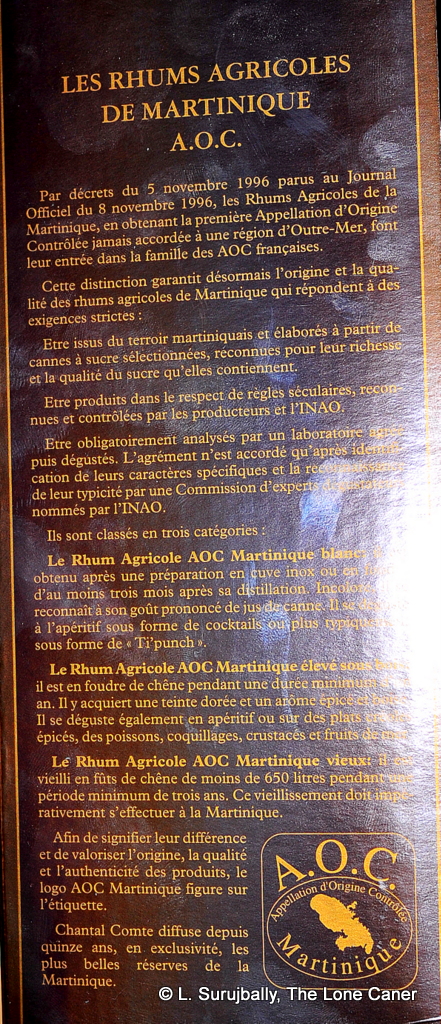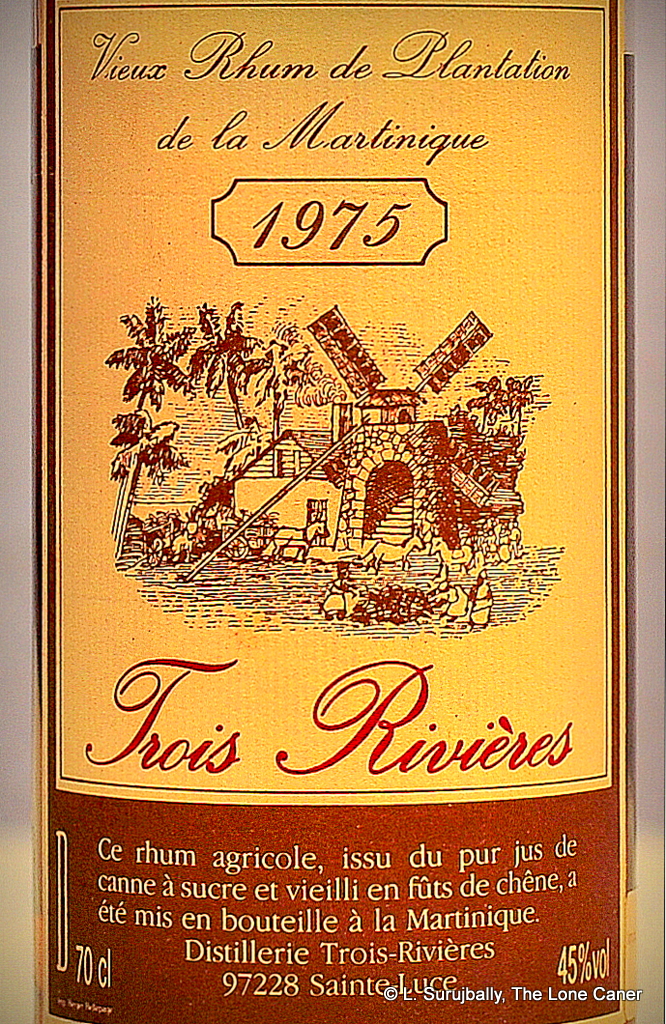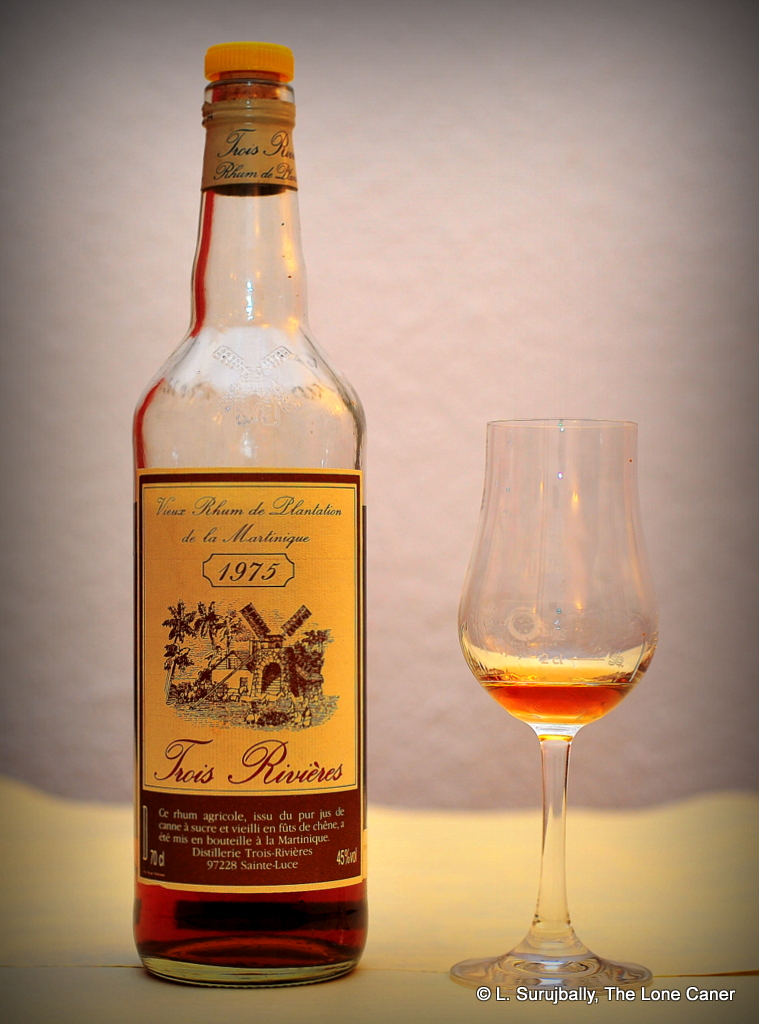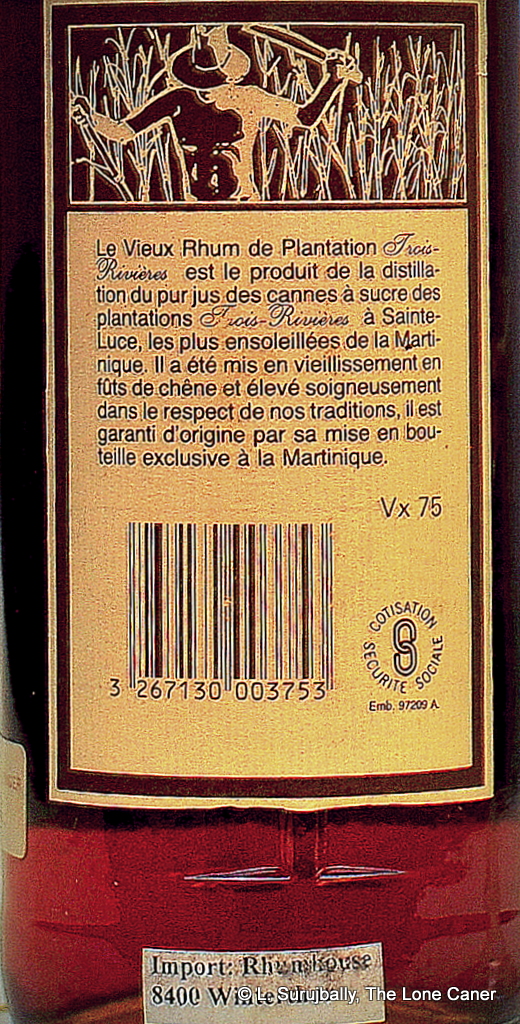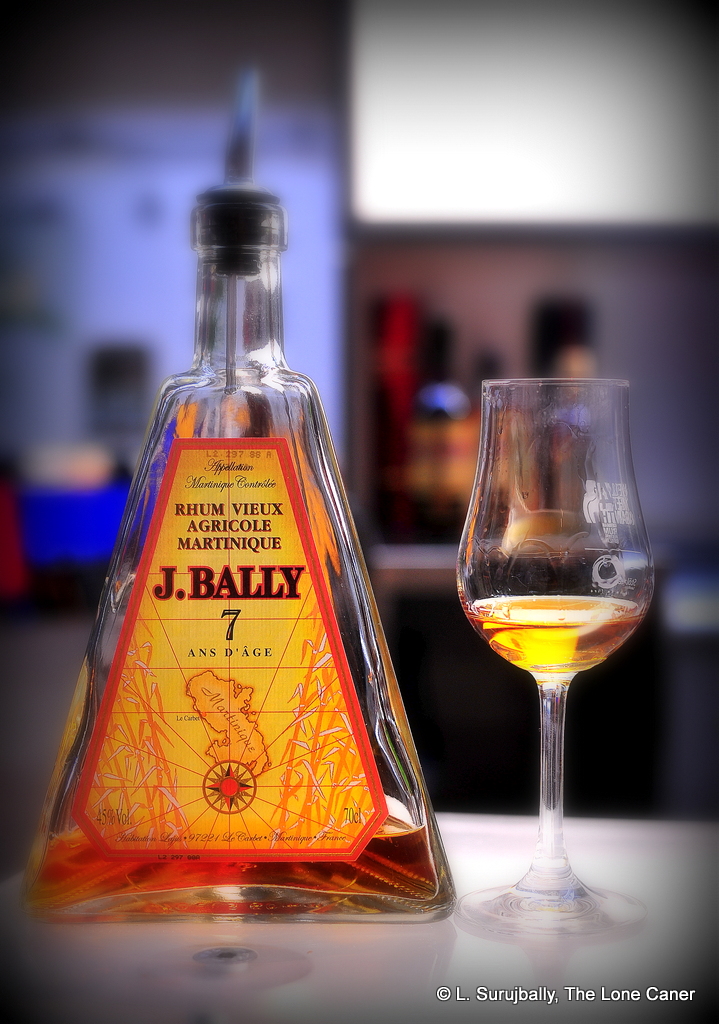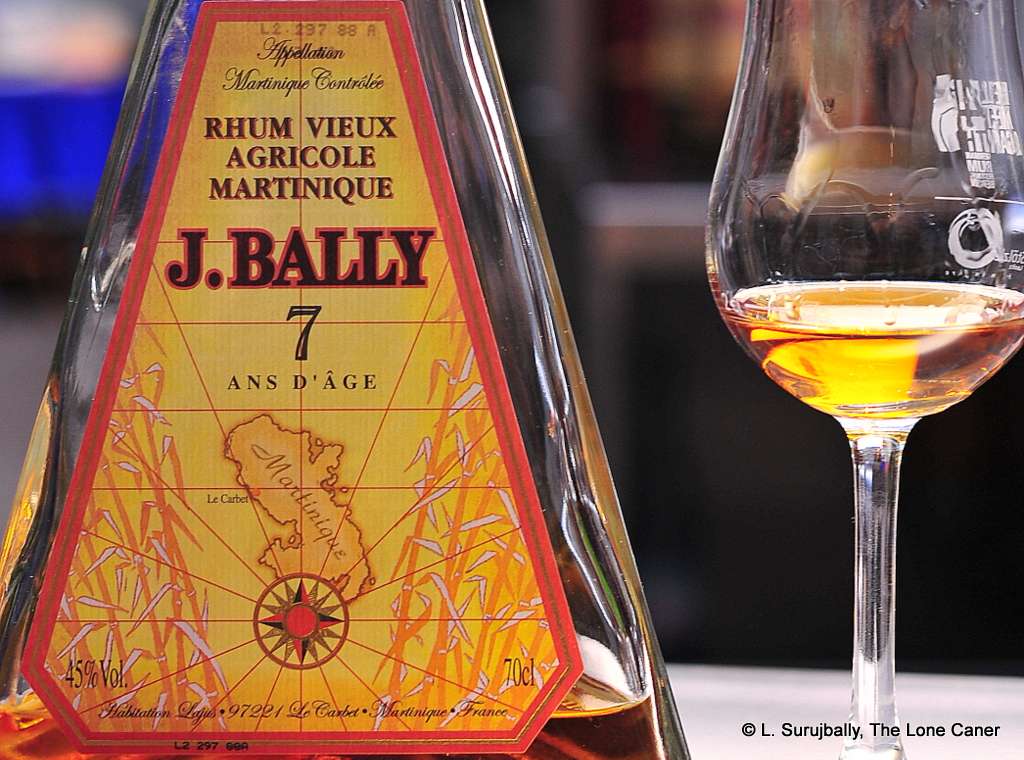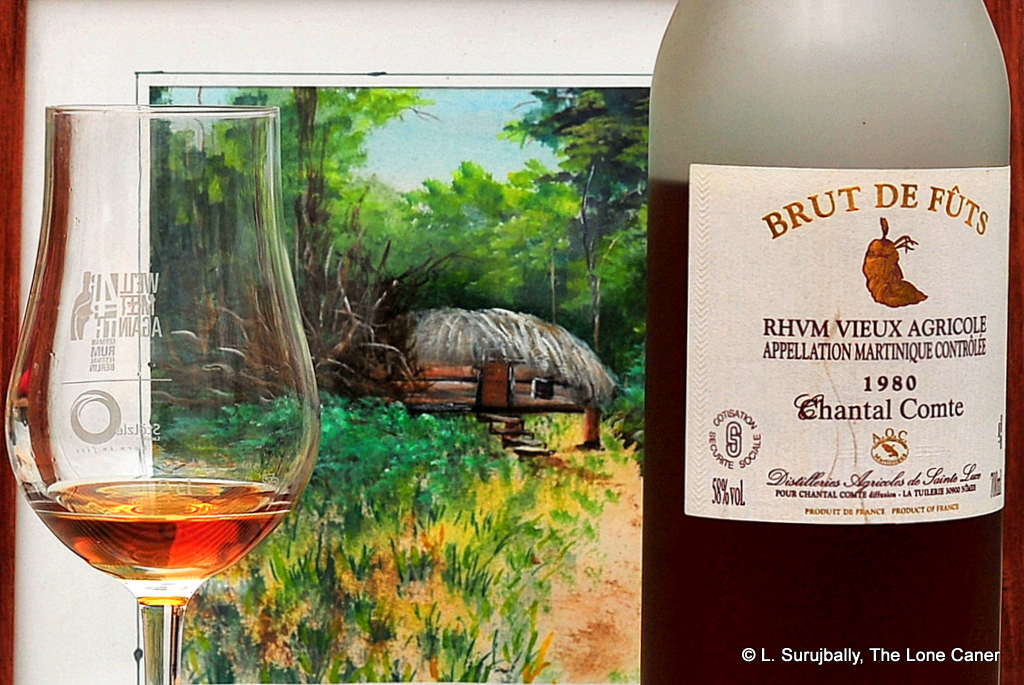
This rhum is a quietly dazzling masterpiece.
The Chantal Comte 1980 purrs away in the glass, containing so many quietly thrumming riches, revealed in so gradual a fashion, that it embarrasses ordinary rums. And yet, its characteristics aren’t gaudily thrown before us to entertain or impress. There are no marketing tricks here, no fancy “finished in…” or “made this unusual way…”. No dosing, adding or off-the-wall ageing. It is only after I tried it for the fourth time that I truly appreciated the full reach of its accomplishment, and realized how well and how subtly it had been made. And all this from a seven year old rum.
The Chantal Comte Rhum Vieux Agricole Appellation Martinique Controllee 1980 (to give it its full title) hails from St. Luce, which is to say Trois Rivieres. Chantal Comte, a lady who owns the Tullieres estate in France, and who also has a long association with the French West Indies, has an appreciation for rhum which many years ago prompted her to begin issuing aged agricoles under her own label. The Hors D’Age from Habitation Ste. Etienne was a wonderful rhum for example, and the 20 Year old St. Luce 1977 Millesime was also pretty good — yet here she does it one better, and perhaps this is one reason why the price of the seven year old 1980 is more than twice that of the 1977 even though less than half as old (that and the fact that 15,000 bottles of the 1977 were issued, versus 1400 of the 1980).
The presentation was somewhat lackluster for a rhum of this price: a black cardboard cylinder enclosing a very handsome frosted glass bottle. Never mind, I’ve made my sniffy observations on this kind of thing before. The label, relatively simple, filled in some of the details noted above. The age was not stated and it took some sleuthing around to have it confirmed that it’s a seven year old…no idea why that was omitted – were they waiting for a reviewer to talk about it, perhaps afraid people would be put off by its single-digit age?
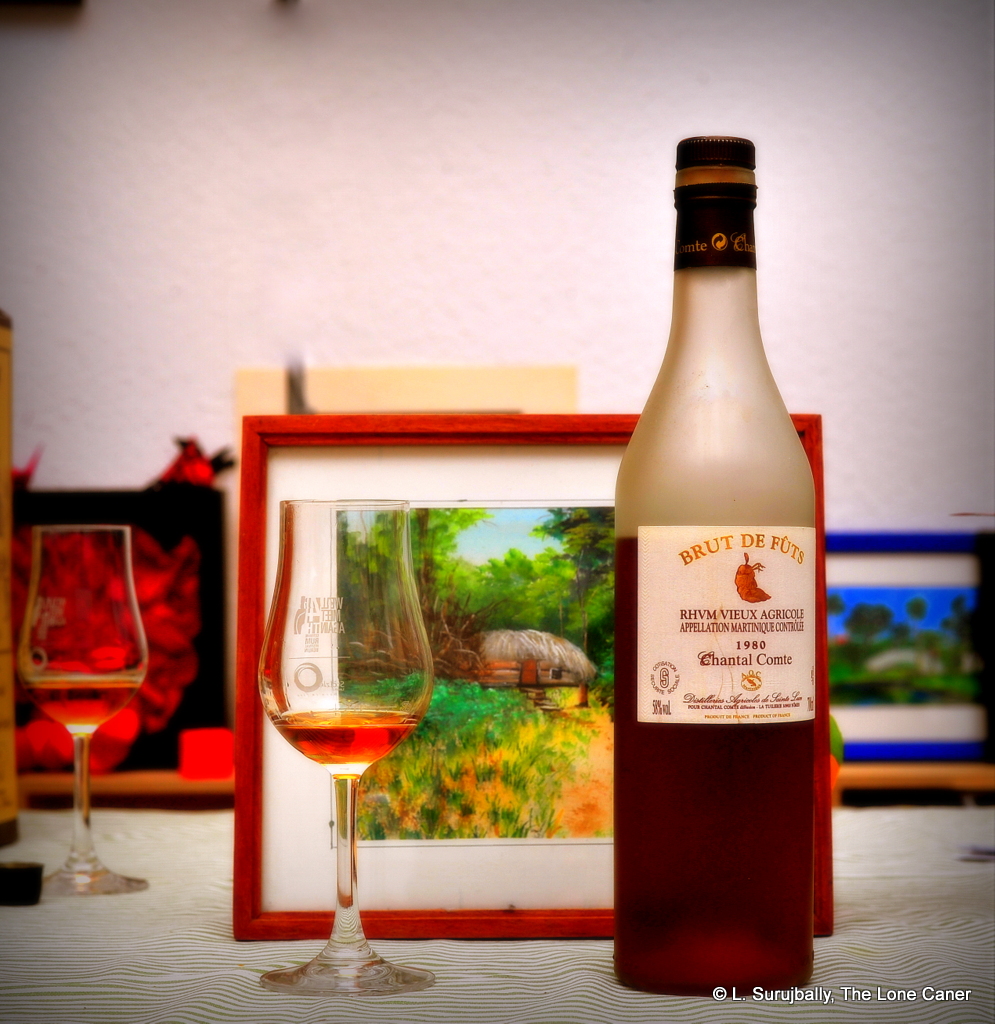
Anyway, forget the preamble and walk with me through the sampling. It was a dark amber rhum, issued at a solid 58%, and the nose…well, all I can say it was great. It was a beautifully rich yet simultaneously subtle, and complex to a fault. An initially warm and delicious melange of fruits, flowers and the faintest background of turpentine and well polished floors. This developed into lavender, toned-down lilies, unripe cherries, everything soft and yet edgy at the same time (that was the 58% speaking – it intensified everything without actually moving the rhum into harsh bitchiness). But this wasn’t the end. We were in the middle of a six hour tasting session and as the hours wore on we kept coming back to this one glass, and by the time it was over, to those flavours we smelled, were added some faint caramel and molasses, vanilla, cinnamon, very faint ginger and baking spices. And all these in a really harmonious balance.
Since it was a relatively strong rhum, I expected some sharpness at the inception of the taste, and indeed this was there. But that dialled itself down to a strong kind of heat that made the experience a much better one after some minutes. It was quite full bodied and intense, and the immediate sensations were of butter cookies with a strawberry jam centre (for the benefit of my friends Henrik and Gregers who were there with me, I’ll say they were Danish); cinnamon again, black cherries teetering on the brink of over-ripeness, plus an assortment of light peaches, apricots, bananas and dark honey. And all this intertwined with the sweetness kept way back, a dusting of leather and smoke, aromatic port infused cigarillos, some drier woody notes, and even some brine…but I must emphasize how extraordinarily well this all came together, without any one aspect dominating any other – it was as well balanced and solid as the keystone in a Roman arch.
As for the finish, well, what can I tell you? It was great, summing up everything that came before: long and a little dry, spicy and wholesome, with both the sweet and the salt of a top-end Japanese soya, finishing things off with some oaky notes, almonds, vanilla, and port.
The construction and gradual unfolding of this thing is amazing. I started by liking it, an hour later I was impressed, and by the time the evening was over I was in love. It took time for the full effect to sink in. It lacks the rough hewn brutality and single-minded intensity of the Veliers, and is perhaps more akin to Rum Nation…just better (perhaps because “dosing” is not part of the assembly). The 1980 may be classed as an AOC agricole, but I honestly think this has aspects of both French and Spanish style rums (with maybe a flirt of Bajan thrown in for good measure). It’s an order of magnitude better than many products twice or three times as old, and thinking I was being too enthusiastic, I tried it four separate times over a week and yep, it was still as good as that first time. It is the best sub-ten year old rum I’ve ever tried.
I truly enjoy rums that are well made and appealing, no matter who makes them, and find that certain companies are consistently top grade. That they are almost all independent bottlers not seeking to dominate their market (though Velier comes close) may be key to the quality of their rums, because they are niche players, not commercial mastodons like Diageo or Bacardi, and therefore they pay careful attention to what they slap their labels on. Their stuff isn’t made by committee, so to speak; perhaps to them money and market share is less important than making rums, not mere products.
Yet, even within the small independent world of Veliers, Compagnie des Indies, Duncan Taylors, Rum Nations, Moon Imports and Samarolis, there are occasional bright shining stars that amaze and awe us with the sheer brilliance of their creations. While it’s obviously an unknown if all of Mme Comte’s rhums operate at the level of the three I have tried so far…I can hope. This rhum is one of the absolute best I’ve had all year, and it earns that accolade not because of stratospheric price or fancy bottle or rarity…but because it really is that extraordinarily good.
(#243. 92/100)
Other notes
- Chantal Comte’s website makes no mention of this rum at all. I contacted the company directly and they told me it was a seven year old, aged in oak (but not what kind).
- I highly recommend, if you ever try this rhum, to take your time with it. The scents and tastes simply grow richer over time.
- The closest rhum to this profile I recall is the Courcelles 1972 which exhibited many of the same characteristics, but was many years older.
Opinion
I read somewhere recently that “French Island style” (agricole) rhums represent less than 10% of market share for rums as a whole. The wonderment is, perhaps, that agricoles continue to exist at all, given the preponderance of molasses based rums in the world. I think they remain an unappreciated resource, rums that live in their own space and time, in places we must be willing to visit, to touch, to sample, to experience. An inability to even concede they are worth trying is a profoundly depressing inadequacy, something like saying black and white, silent or subtitled films have no place in the world overrun by remakes, sequels and superhero retreads. Those who casually deny themselves such rhums are also denying themselves the building blocks of the drinking imagination.
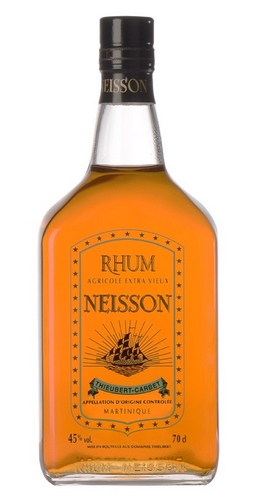
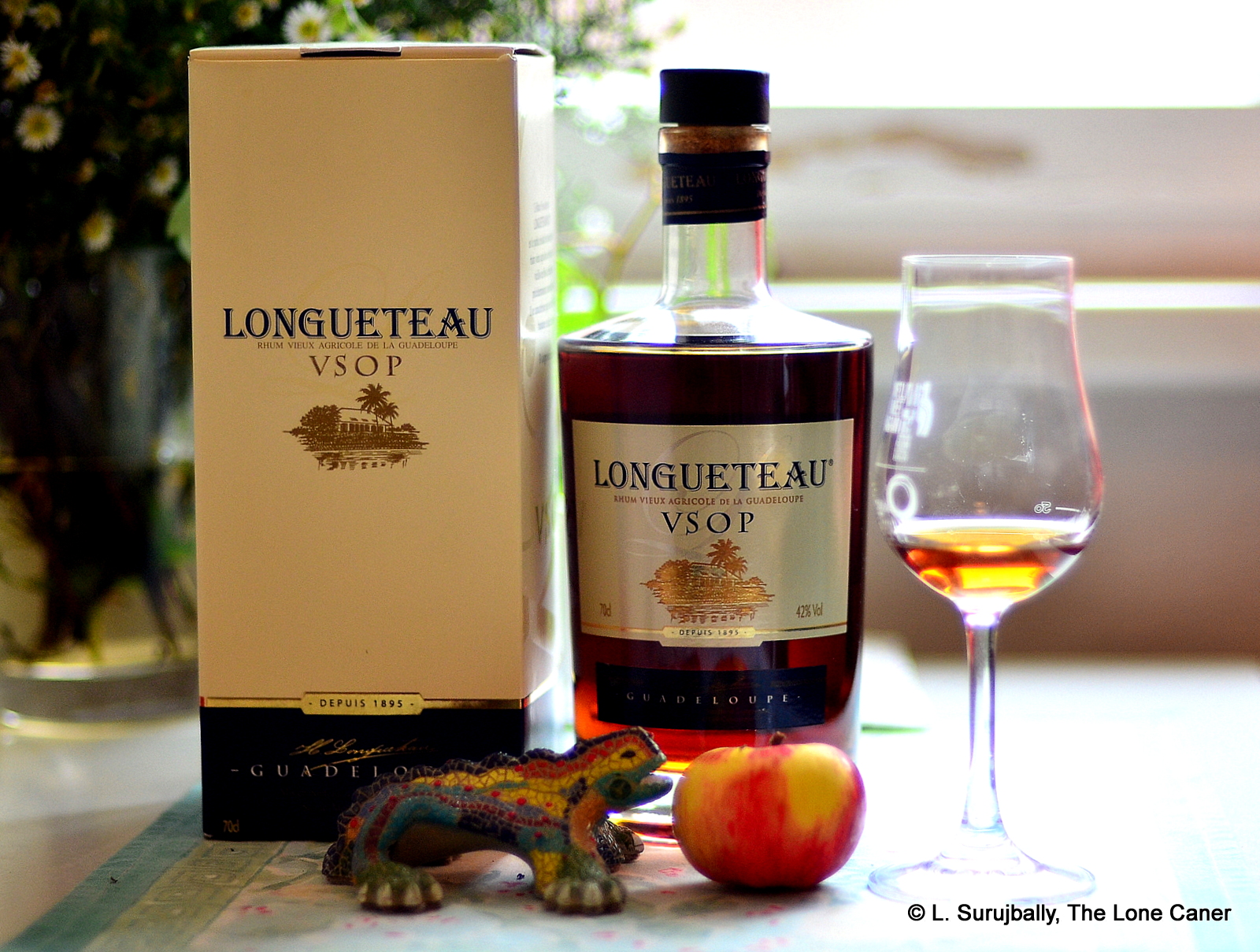
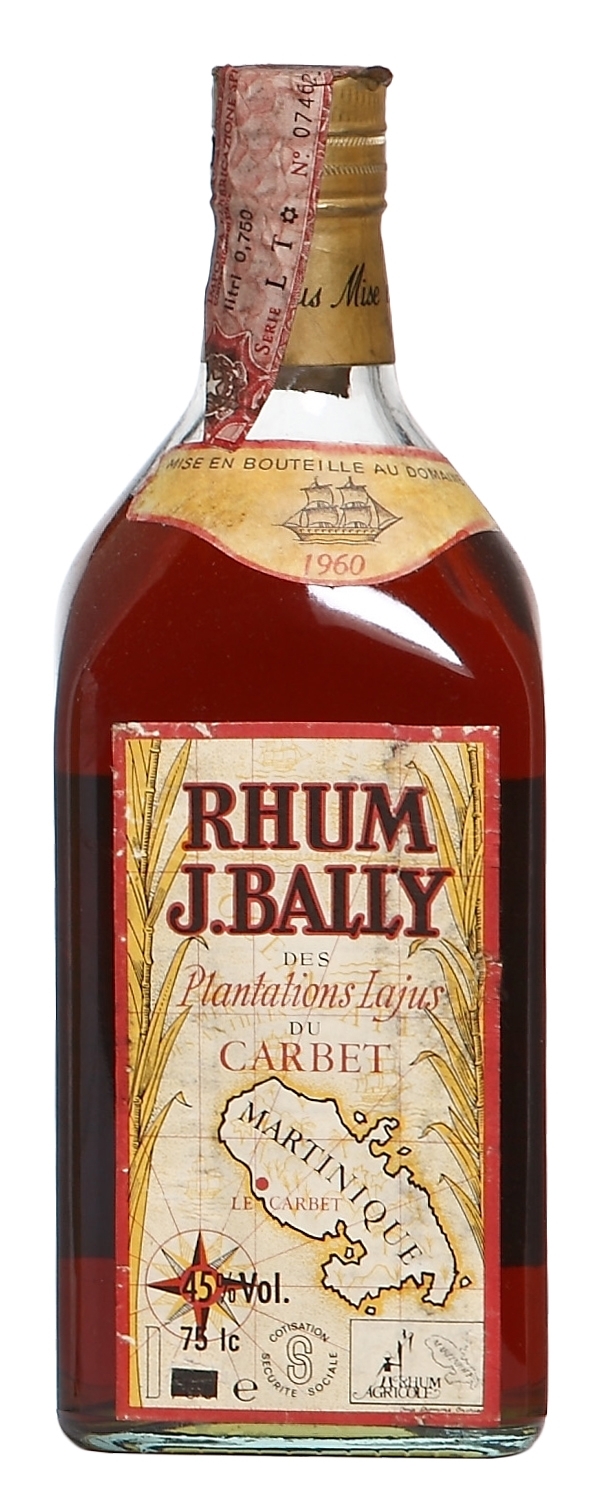
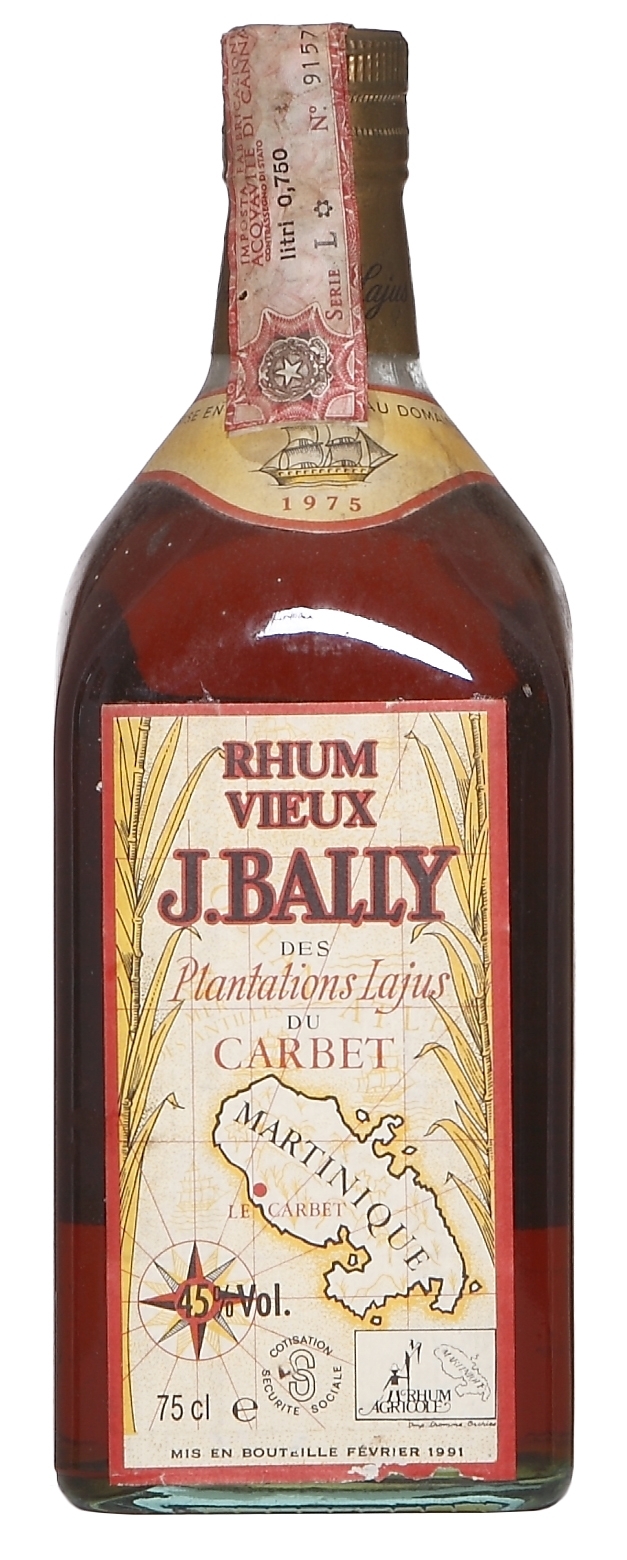
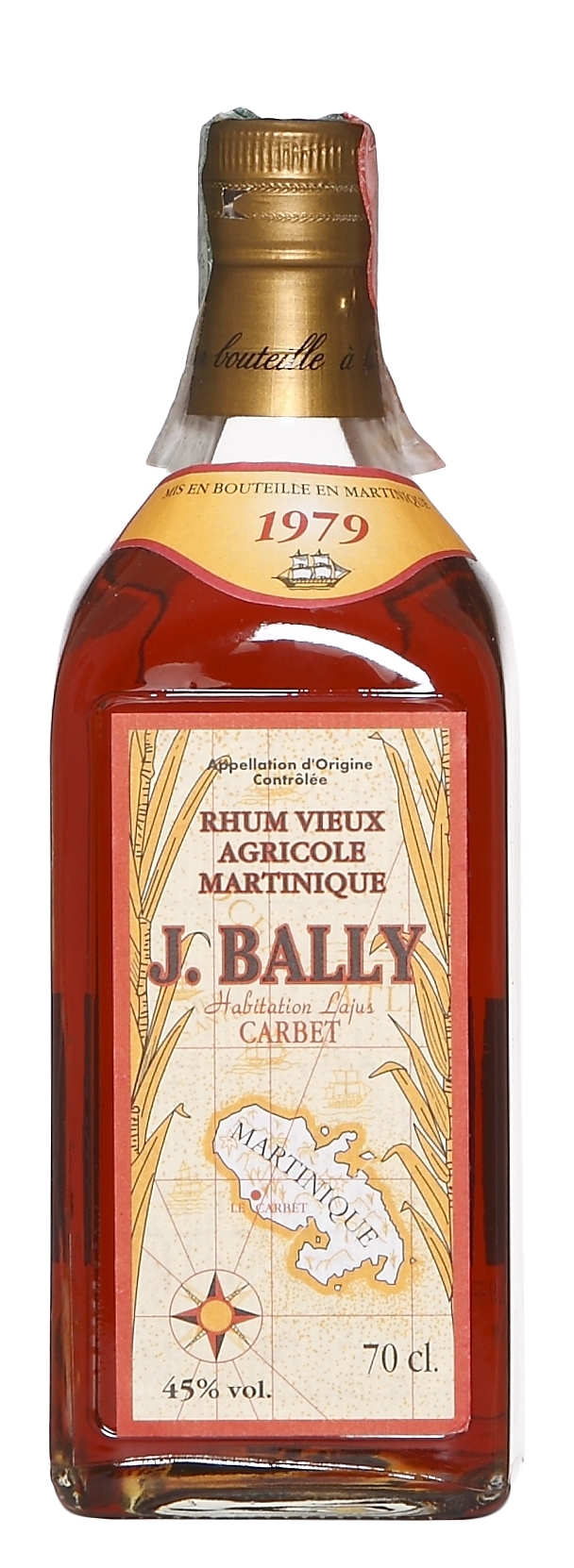
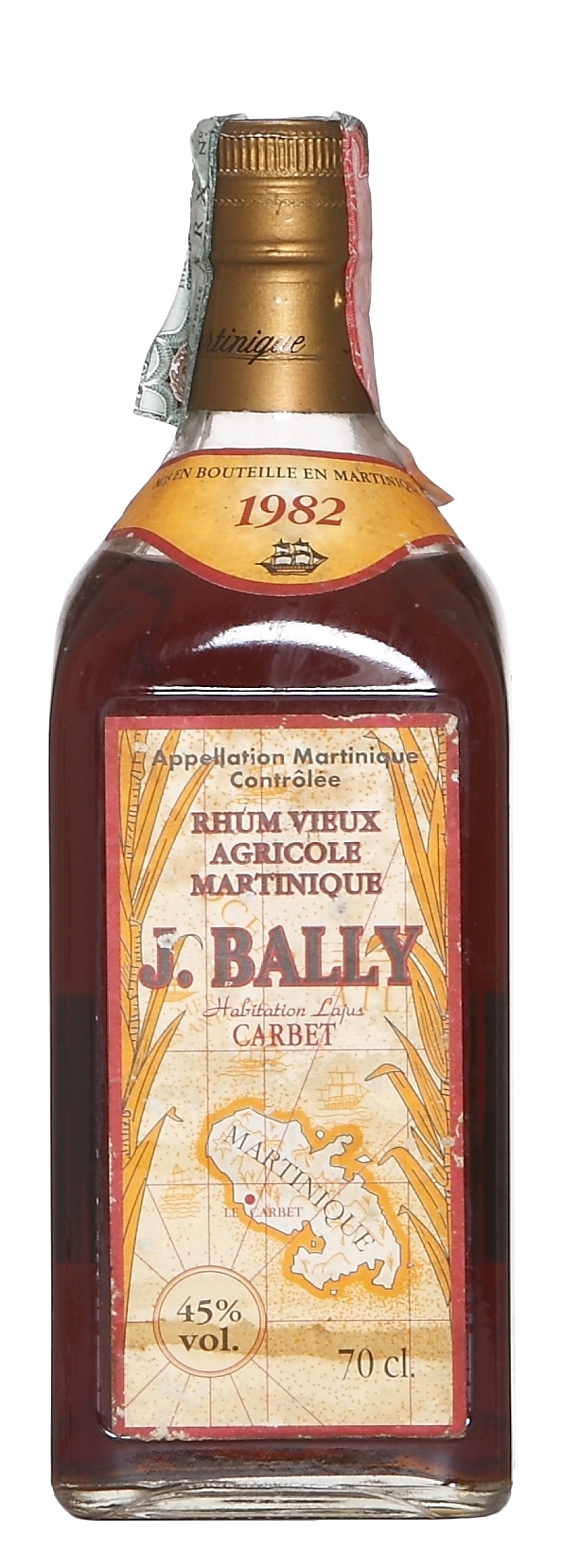
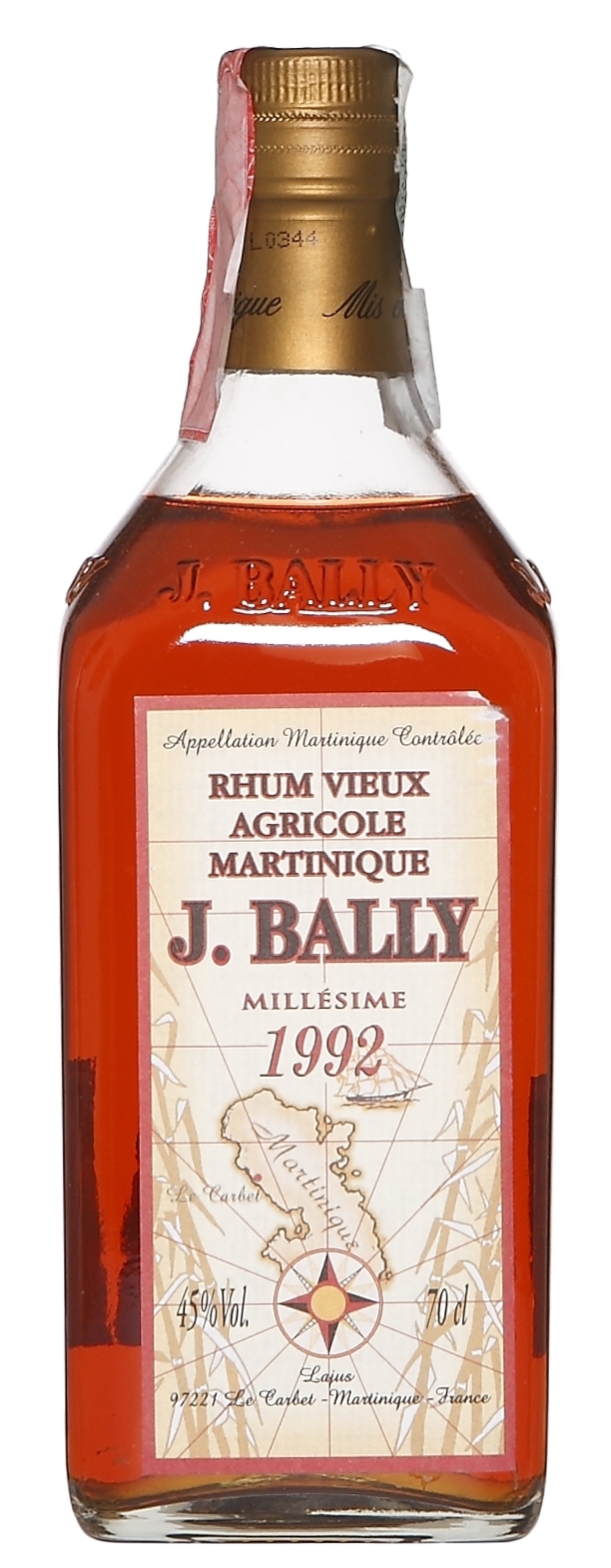
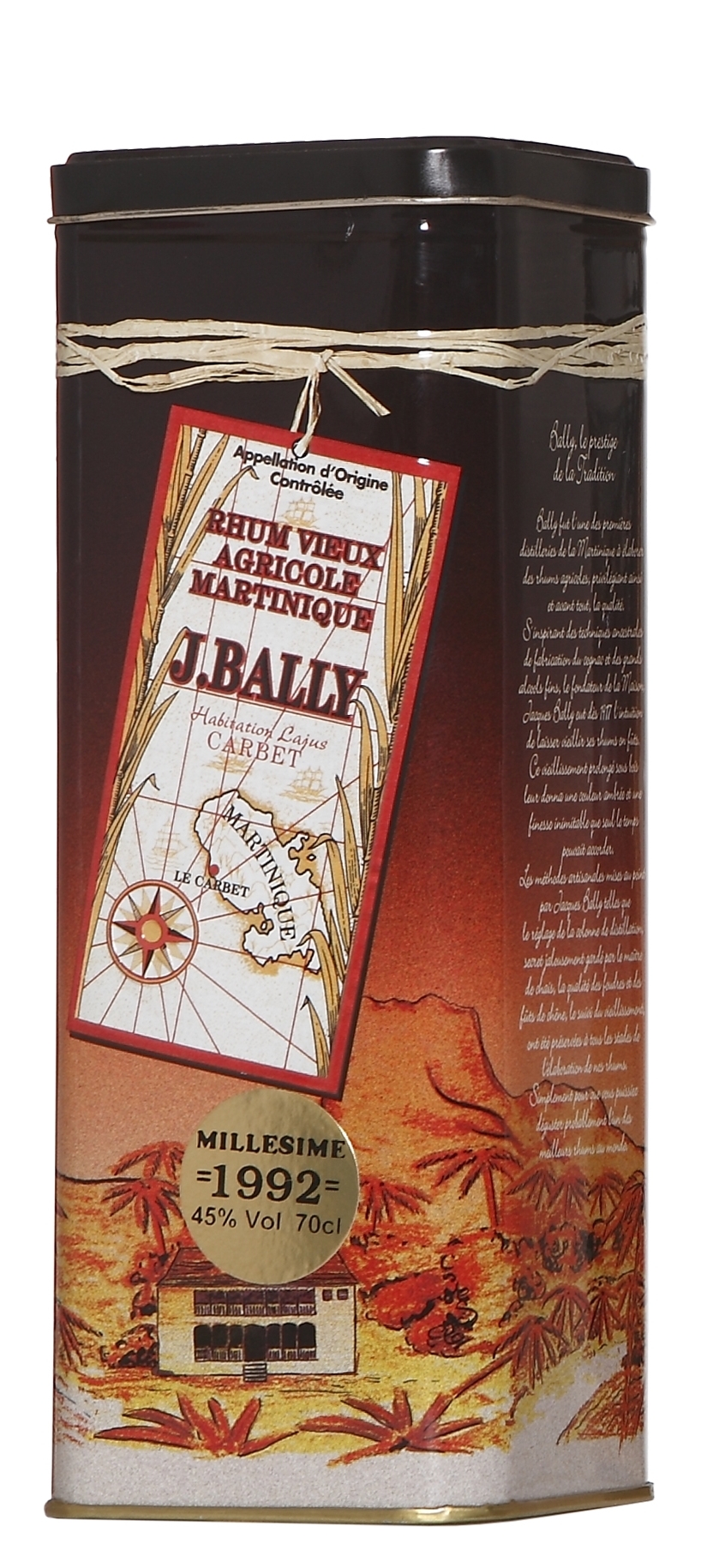
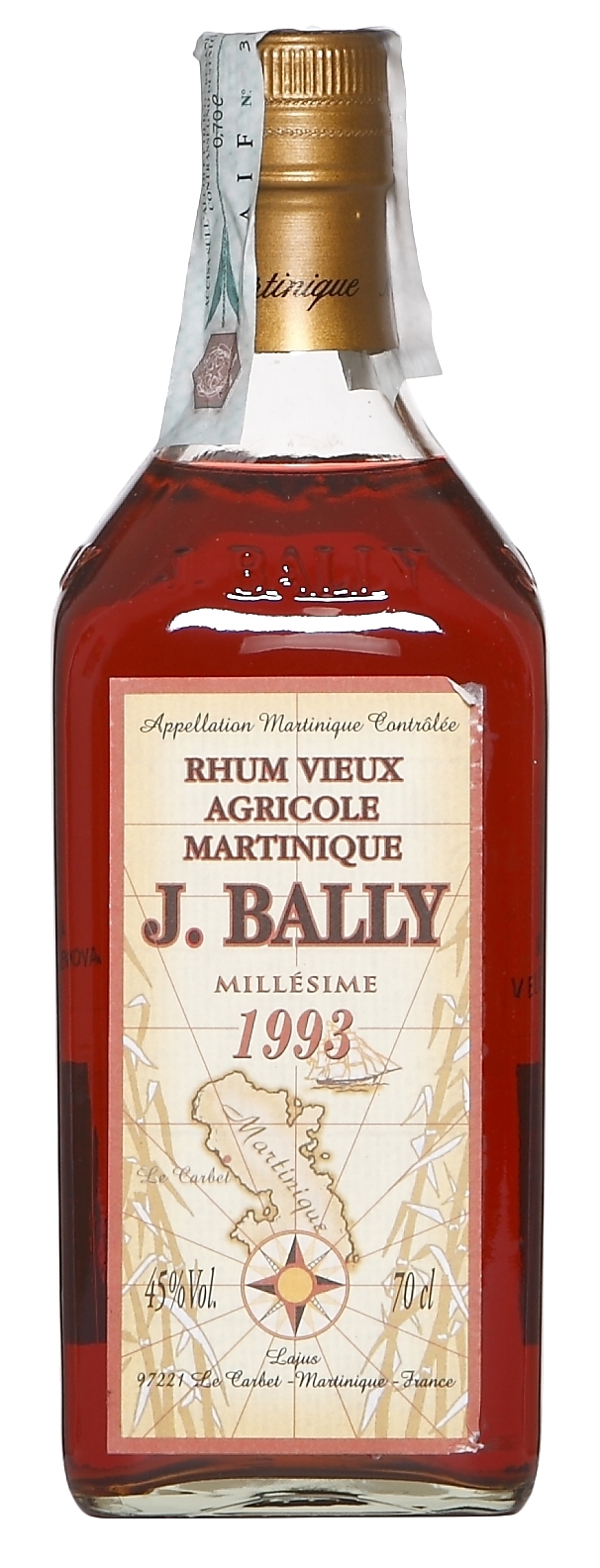
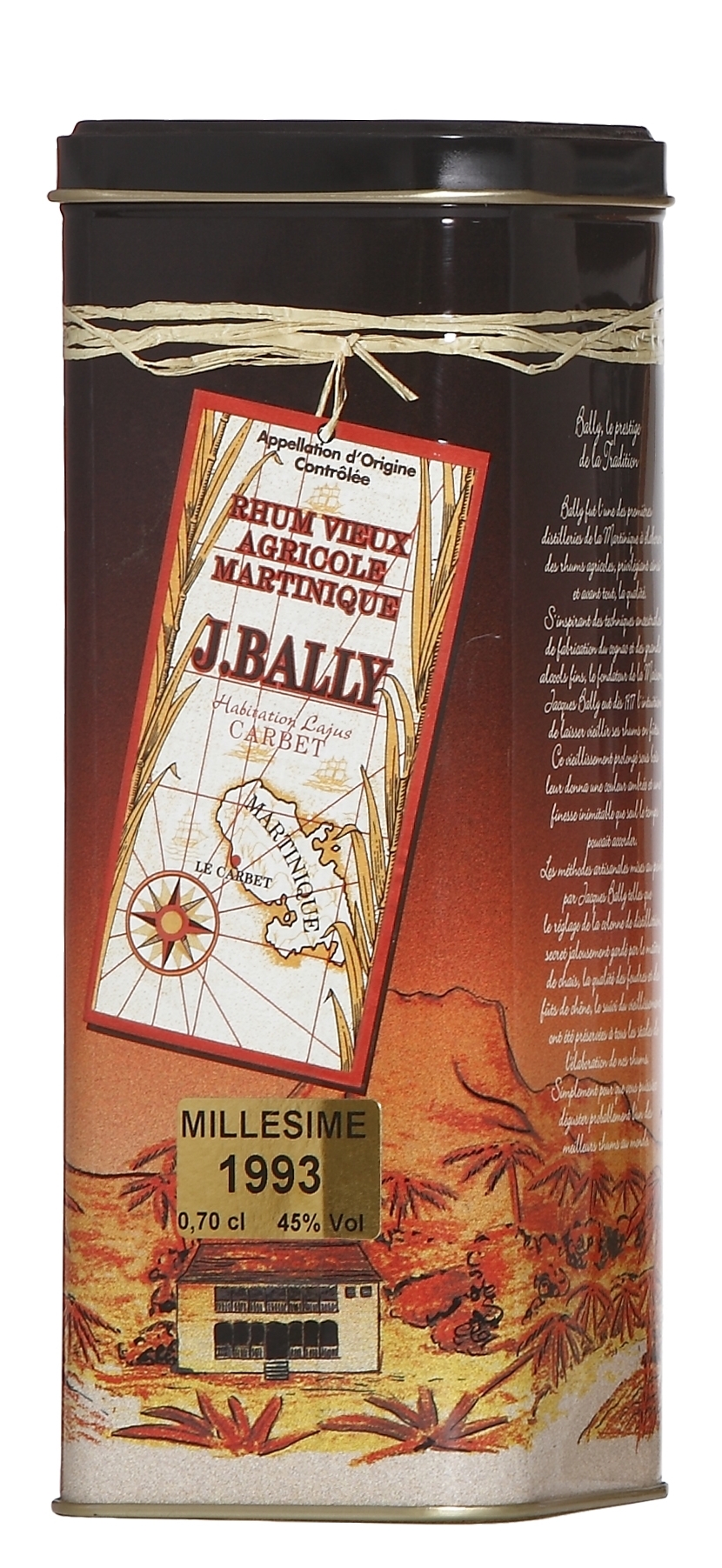
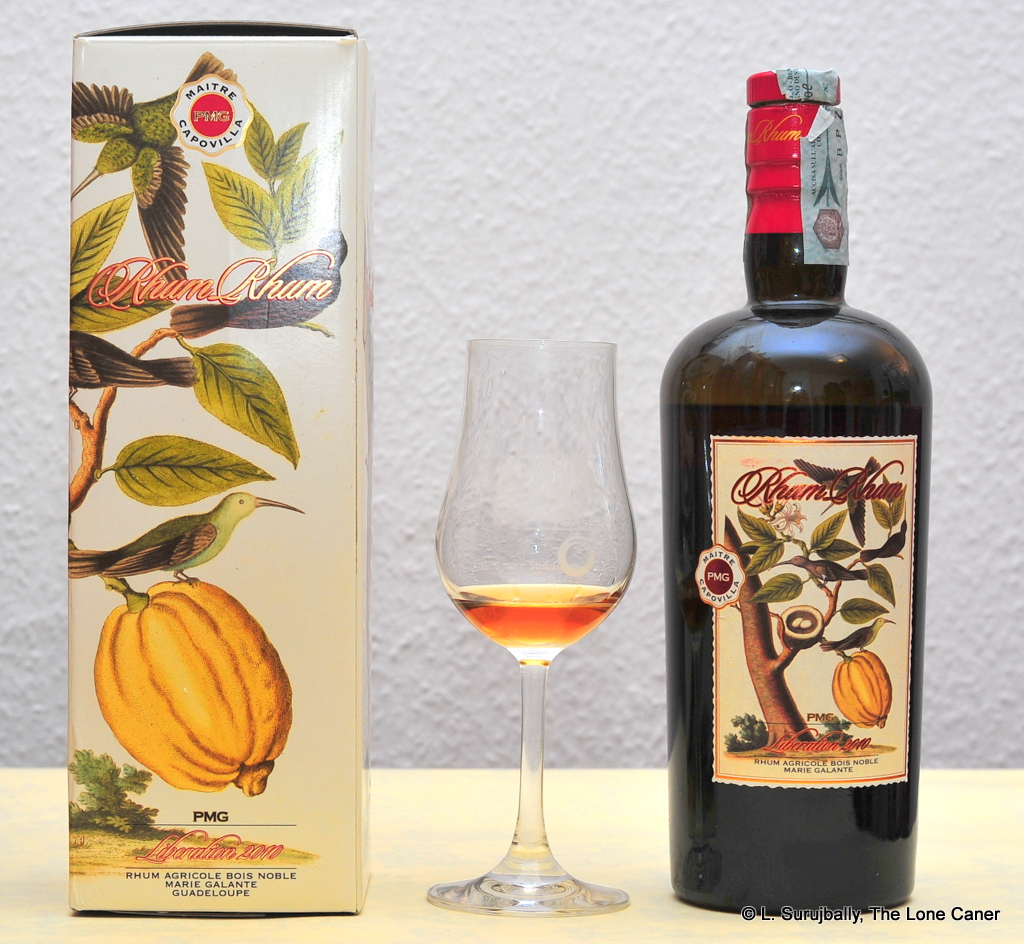
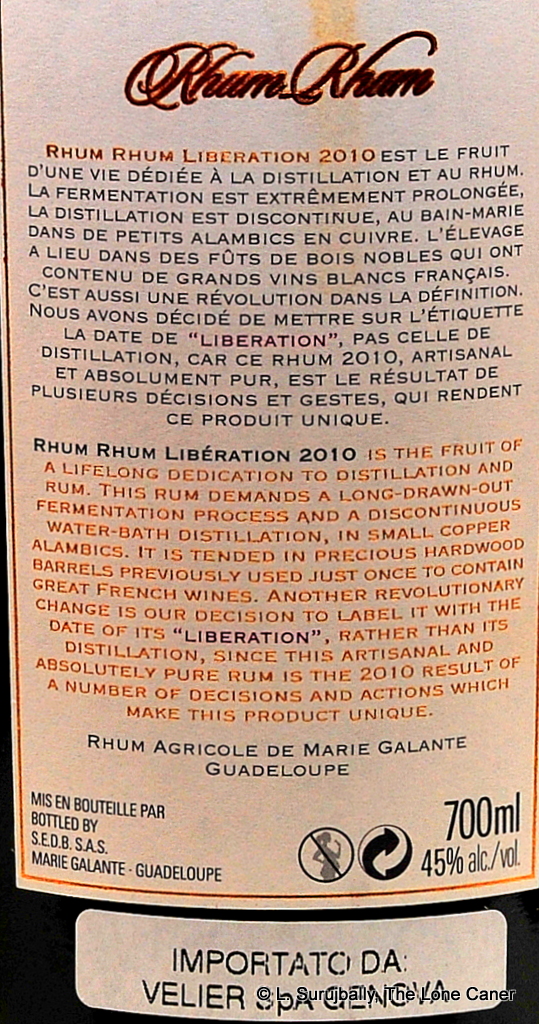
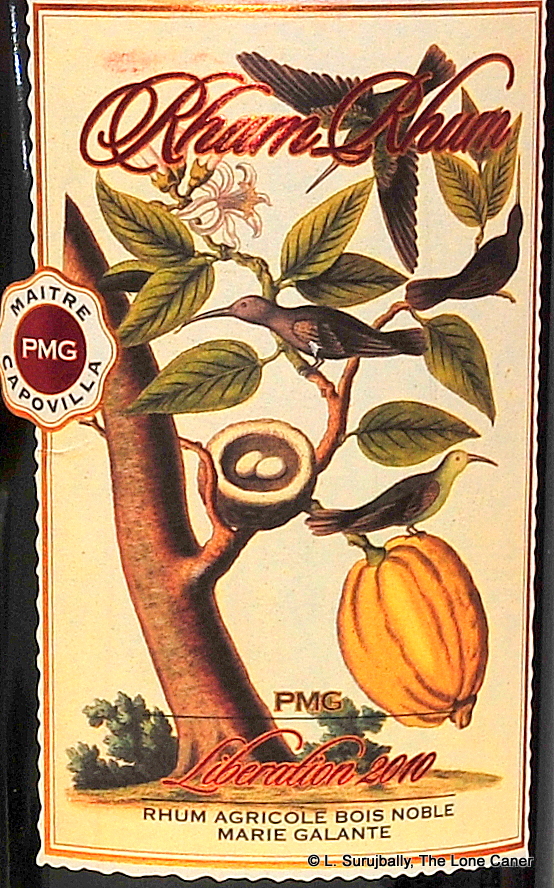
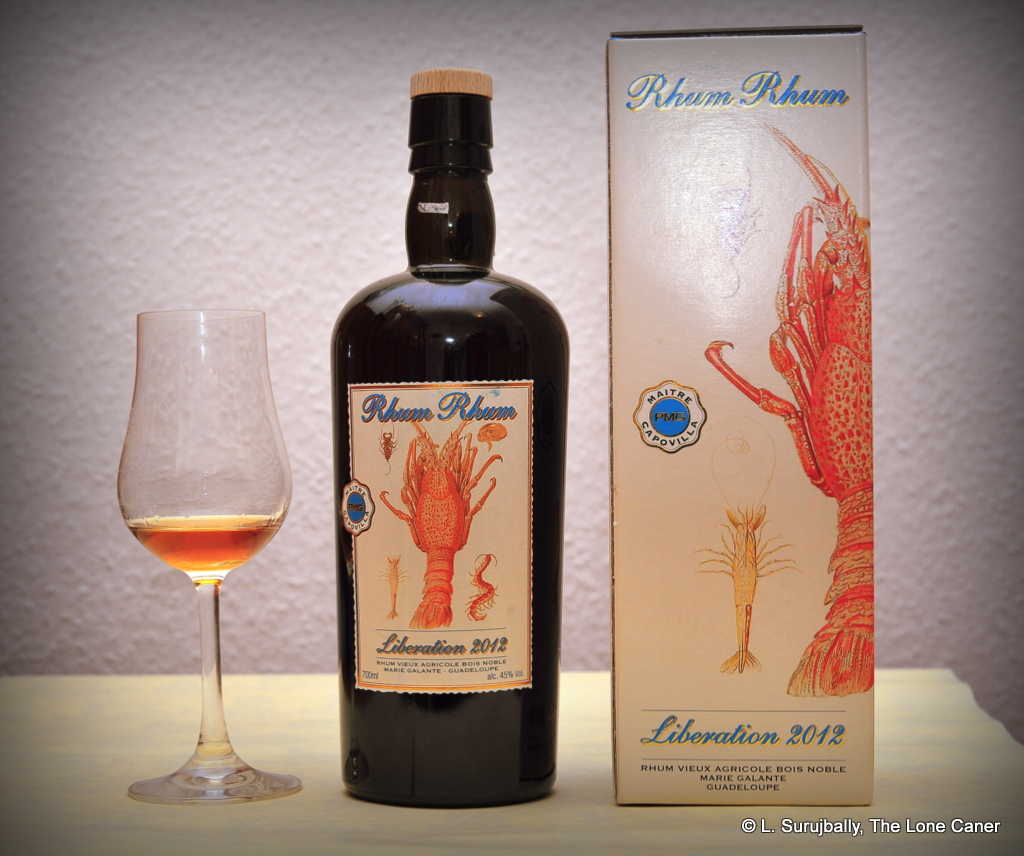
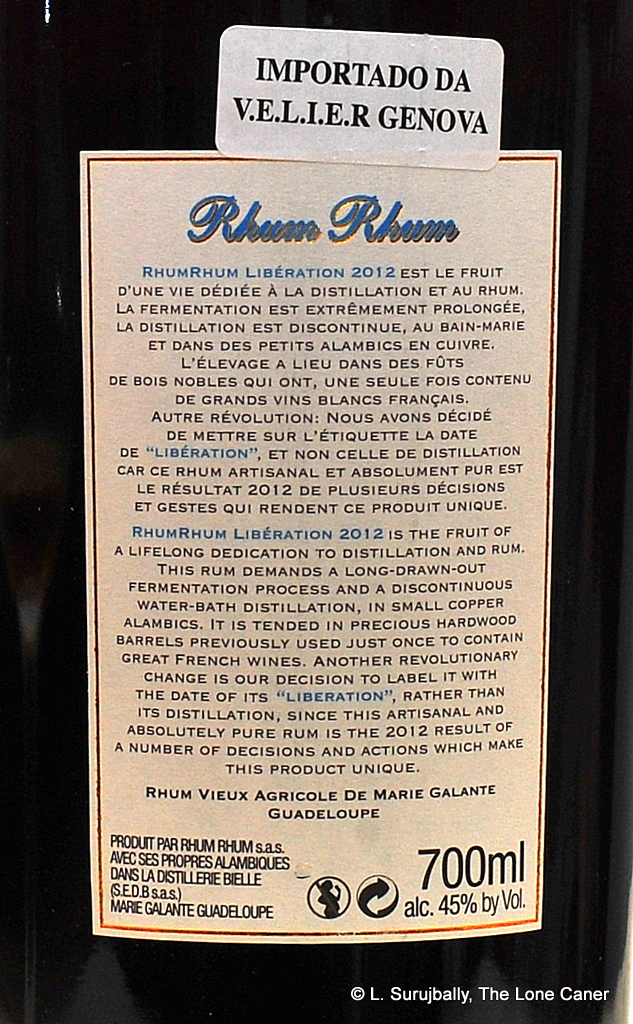
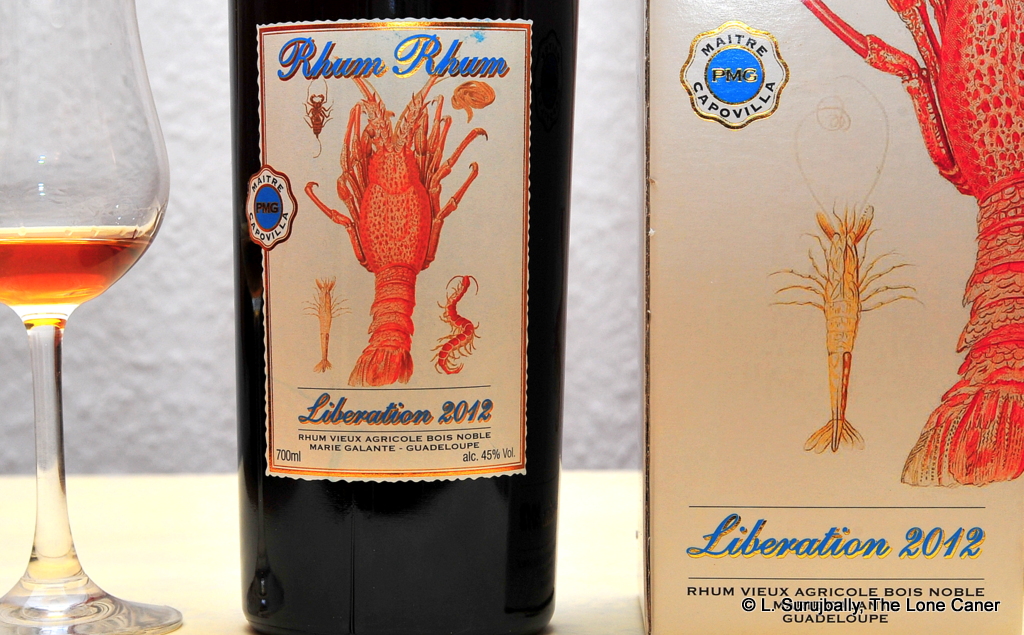
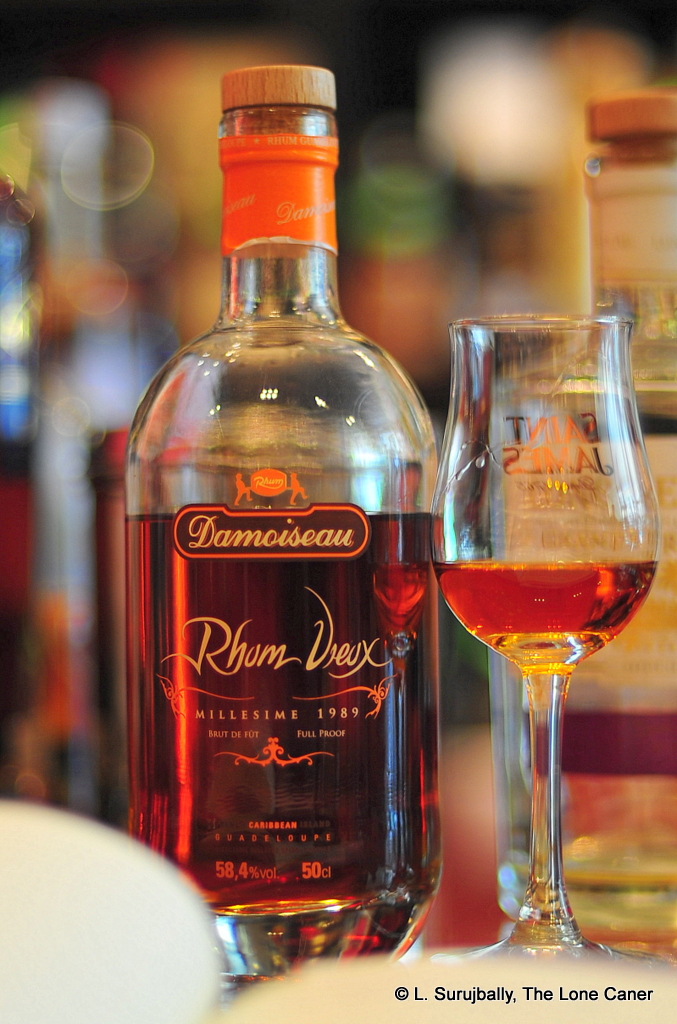

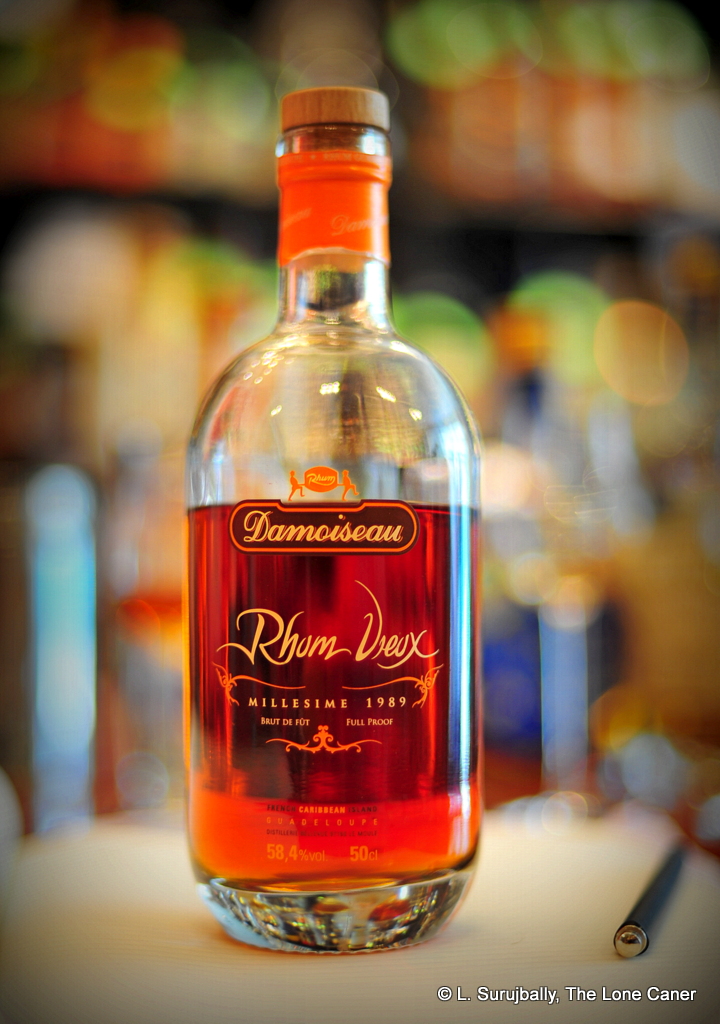
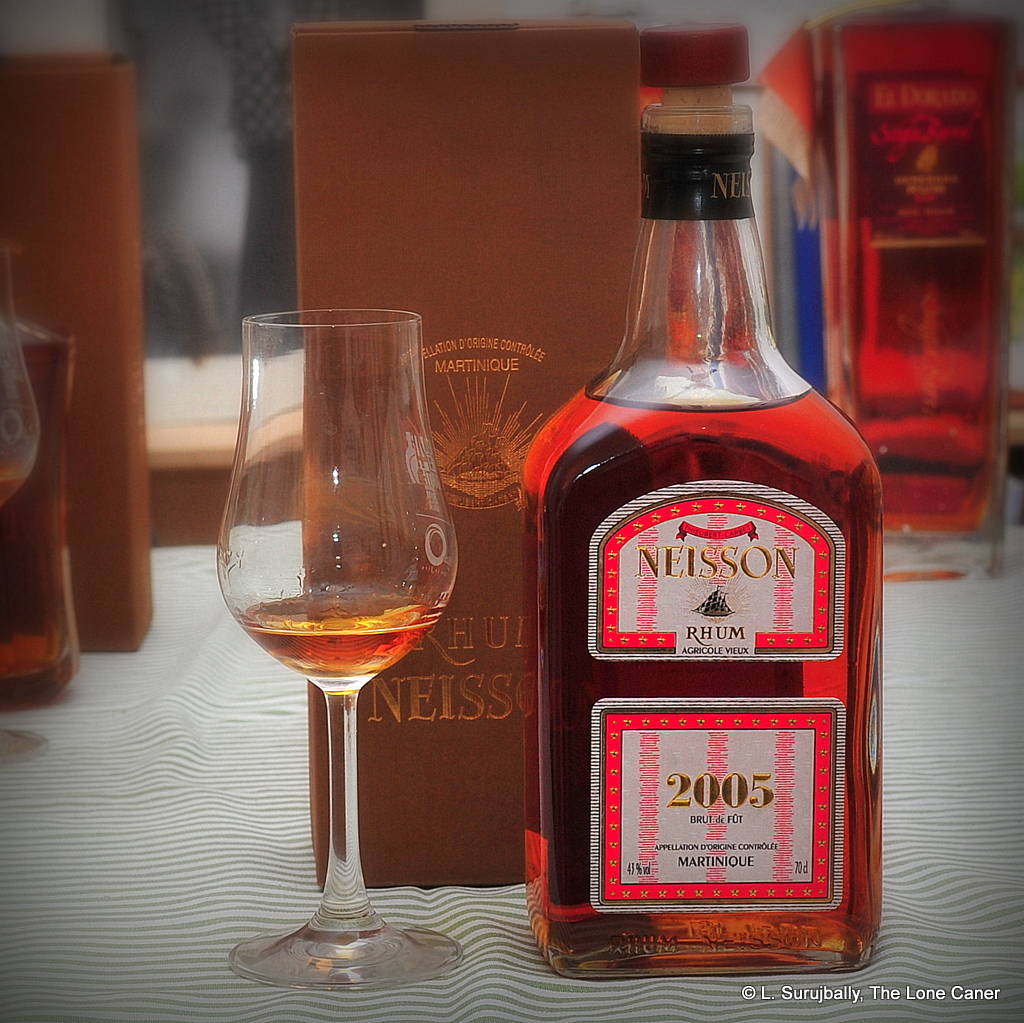
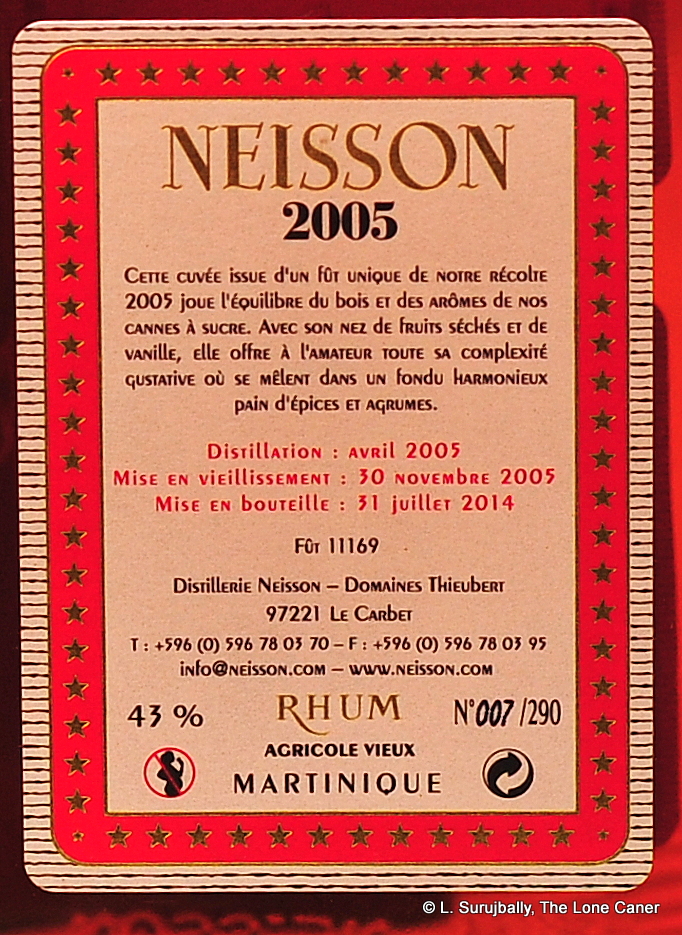 I speak of course of that oily, sweet salt tequila note that I’ve noted on all Neissons so far. What made this one a standout in its own way was the manner in which that portion of the profile was dialled down and restrained on the nose – the 43% made it an easy sniff, rich and warm, redolent of apples, pears,and watermelons…and that was just the beginning. As the rhum opened up, the fleshier fruits came forward (apricots, ripe red cherries, pears, papayas, rosemary, fennel, attar of roses) and I noted with some surprise the way more traditional herbal and grassy sugar cane sap notes really took a backseat – it didn’t make it a bad rhum in any way, just a different one, somewhat at right angles to what one might have expected.
I speak of course of that oily, sweet salt tequila note that I’ve noted on all Neissons so far. What made this one a standout in its own way was the manner in which that portion of the profile was dialled down and restrained on the nose – the 43% made it an easy sniff, rich and warm, redolent of apples, pears,and watermelons…and that was just the beginning. As the rhum opened up, the fleshier fruits came forward (apricots, ripe red cherries, pears, papayas, rosemary, fennel, attar of roses) and I noted with some surprise the way more traditional herbal and grassy sugar cane sap notes really took a backseat – it didn’t make it a bad rhum in any way, just a different one, somewhat at right angles to what one might have expected.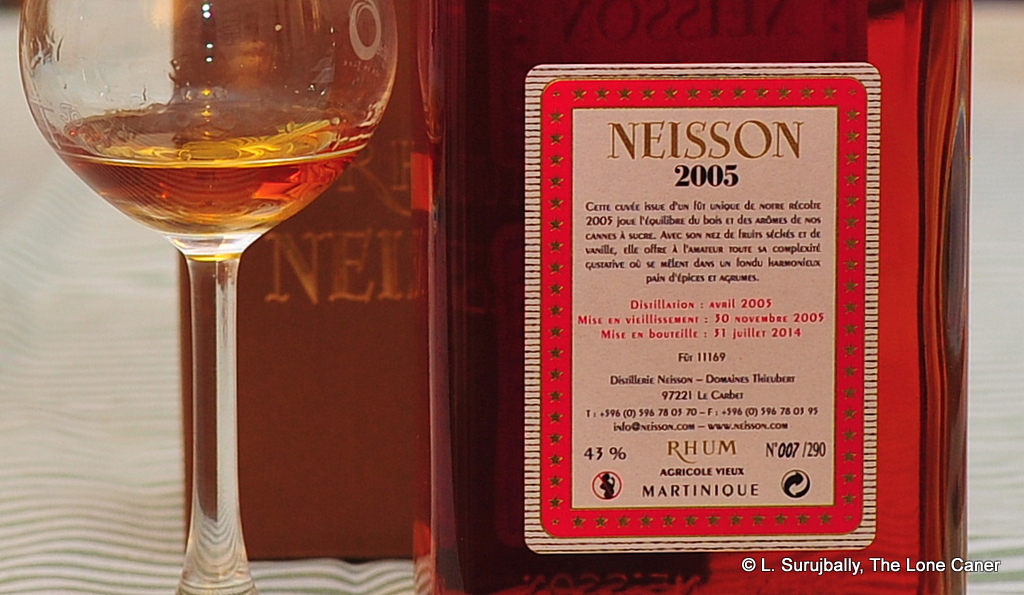 But I also didn’t get much in the way of wonder, of amazement, of excitement…something that would enthuse me so much that I couldn’t wait to write this and share my discovery. That doesn’t make it a bad rhum at all (as stated, I thought it was damned good on its own merits, and my score reflects that)…on the other hand, it hardly makes you drop the wife off to her favourite sale and rush out to the nearest shop, now, does it?
But I also didn’t get much in the way of wonder, of amazement, of excitement…something that would enthuse me so much that I couldn’t wait to write this and share my discovery. That doesn’t make it a bad rhum at all (as stated, I thought it was damned good on its own merits, and my score reflects that)…on the other hand, it hardly makes you drop the wife off to her favourite sale and rush out to the nearest shop, now, does it?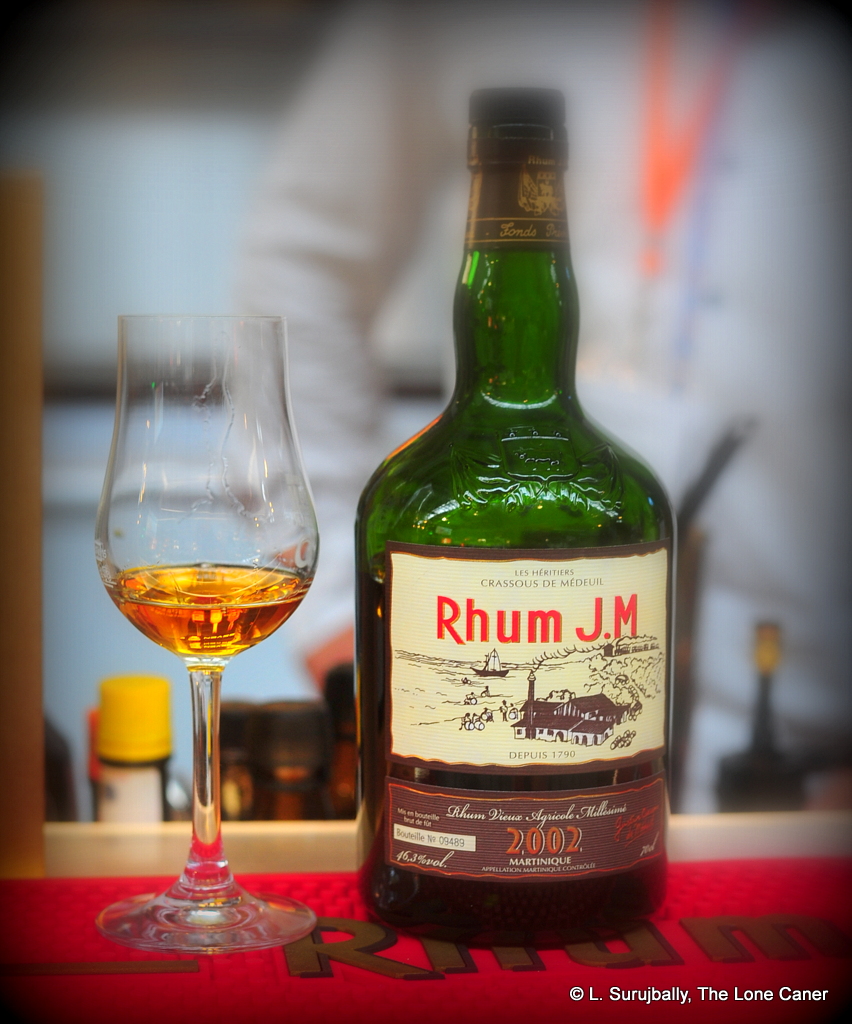
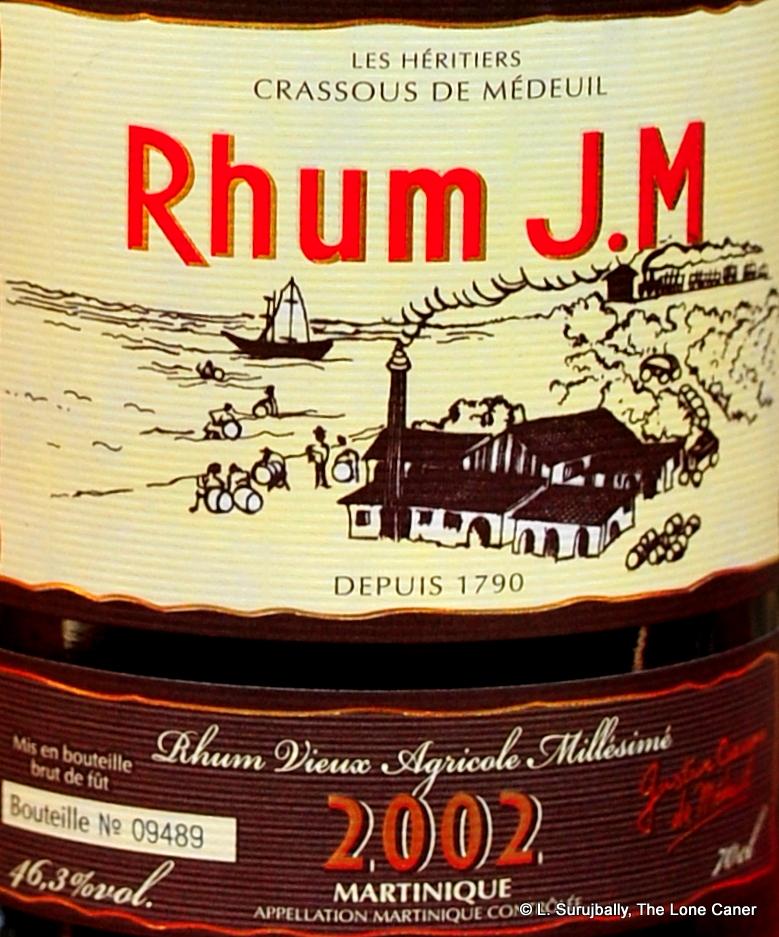
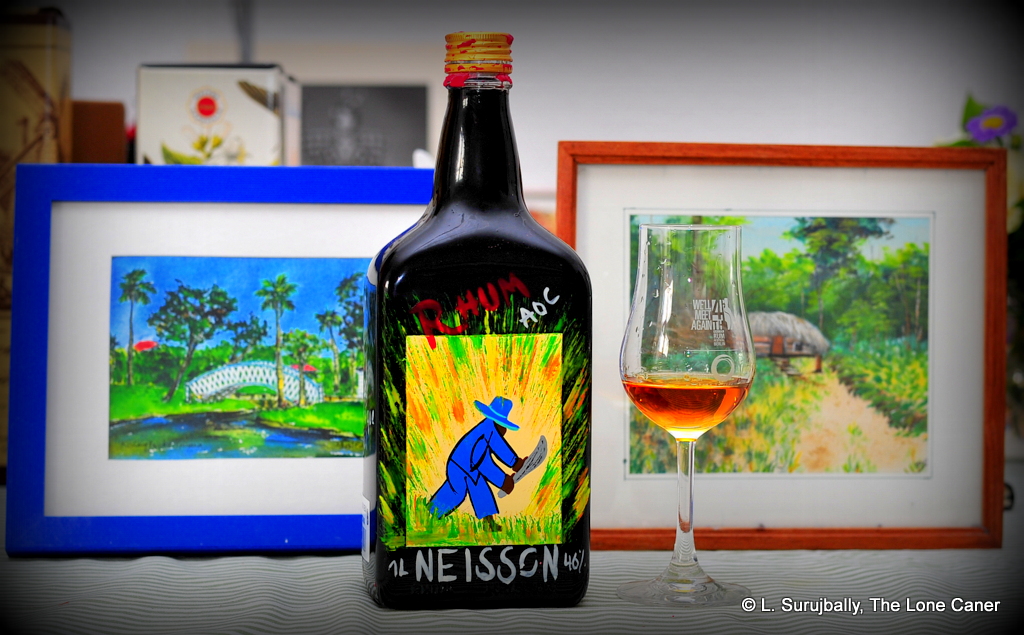
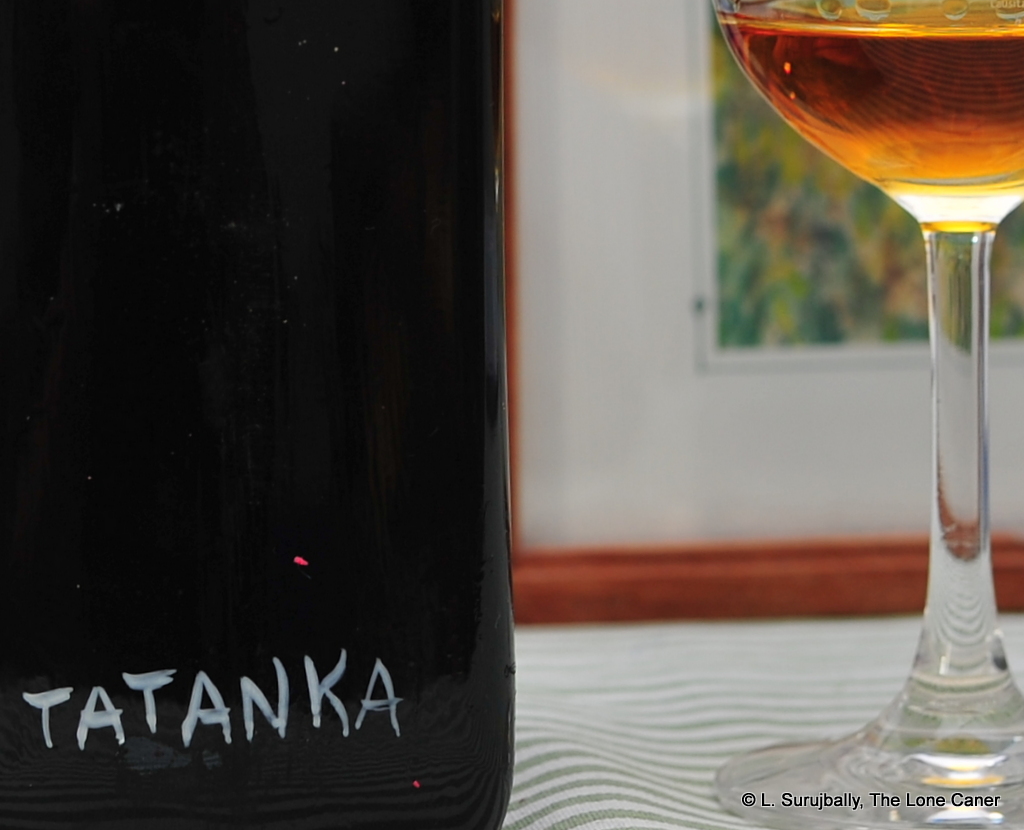 Okay, I jest a little, but consider the nose on the 46% orange-gold spirit. It displayed that same spicy, musky and almost meaty scent of salt butter and olives and tequila doing some bodacious ragtime, sweat and stale eau-de-vie going off in all directions. It was thick and warm to smell, mellowing out into more fleshy, overripe (almost going bad) mangoes and papayas and pineapples, just not so sweet. Spices, maybe cardamom, and some wet coffee grounds. At the back end, after a while, it was possible to detect the leather and smoke and slight bitter whisper of some wood tannins hinting at some unspecified ageing, but where was the crisp, clear aroma of an agricole? The grasses and herbaceous lightness that so characterizes the style? I honestly couldn’t smell it clearly, could barely sense it – so, points for originality, not so much for recognition (though admittedly, that was just me, and your own mileage may vary;
Okay, I jest a little, but consider the nose on the 46% orange-gold spirit. It displayed that same spicy, musky and almost meaty scent of salt butter and olives and tequila doing some bodacious ragtime, sweat and stale eau-de-vie going off in all directions. It was thick and warm to smell, mellowing out into more fleshy, overripe (almost going bad) mangoes and papayas and pineapples, just not so sweet. Spices, maybe cardamom, and some wet coffee grounds. At the back end, after a while, it was possible to detect the leather and smoke and slight bitter whisper of some wood tannins hinting at some unspecified ageing, but where was the crisp, clear aroma of an agricole? The grasses and herbaceous lightness that so characterizes the style? I honestly couldn’t smell it clearly, could barely sense it – so, points for originality, not so much for recognition (though admittedly, that was just me, and your own mileage may vary; 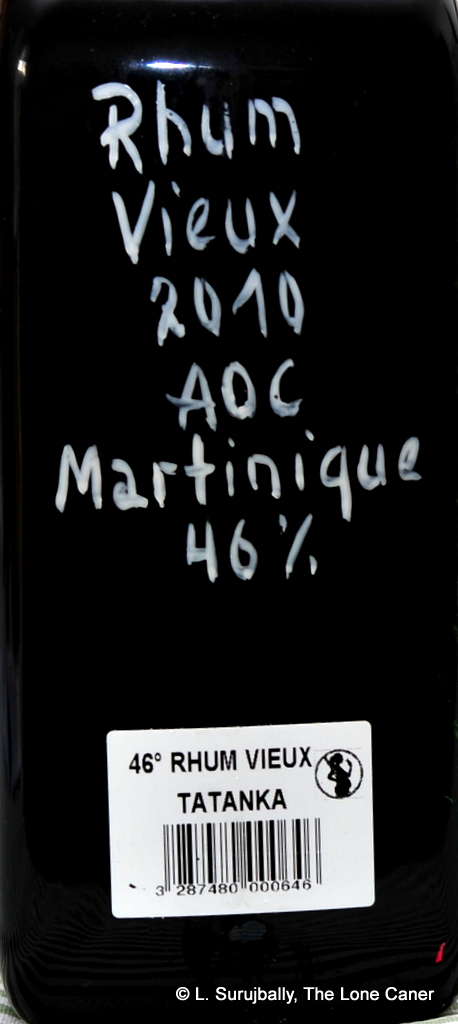 Still, there was little to find fault with once I actually got around to tasting the medium-going-on-heavy rhum. Once one got past the briny, slightly bitter initial profile, things warmed up, and it got interesting in a hurry. Green olives, peppers, some spice and bite, sure, but there was softer stuff coiling underneath too: peaches, apricots, overripe cherries (on the verge of going bad); salt beef and butter again (the concomitant creaminess was quite appealing), and I dunno, a chutney of some kind, stuffed with dill and sage. Like I said, really interesting – it was quite a unique taste profile. And the finish followed along from there – soft and warm and lasting, with sweet and salt and dusty hay mixing well – I am not reaching when I say it reminded me of the mingled dusty scents of a small cornershop in Guyana, where jars of sweets and medicines and noodles and dried veggies were on open display, and my brother and I would go to buy nibbles and maybe try to sneak into the pool hall next door.
Still, there was little to find fault with once I actually got around to tasting the medium-going-on-heavy rhum. Once one got past the briny, slightly bitter initial profile, things warmed up, and it got interesting in a hurry. Green olives, peppers, some spice and bite, sure, but there was softer stuff coiling underneath too: peaches, apricots, overripe cherries (on the verge of going bad); salt beef and butter again (the concomitant creaminess was quite appealing), and I dunno, a chutney of some kind, stuffed with dill and sage. Like I said, really interesting – it was quite a unique taste profile. And the finish followed along from there – soft and warm and lasting, with sweet and salt and dusty hay mixing well – I am not reaching when I say it reminded me of the mingled dusty scents of a small cornershop in Guyana, where jars of sweets and medicines and noodles and dried veggies were on open display, and my brother and I would go to buy nibbles and maybe try to sneak into the pool hall next door.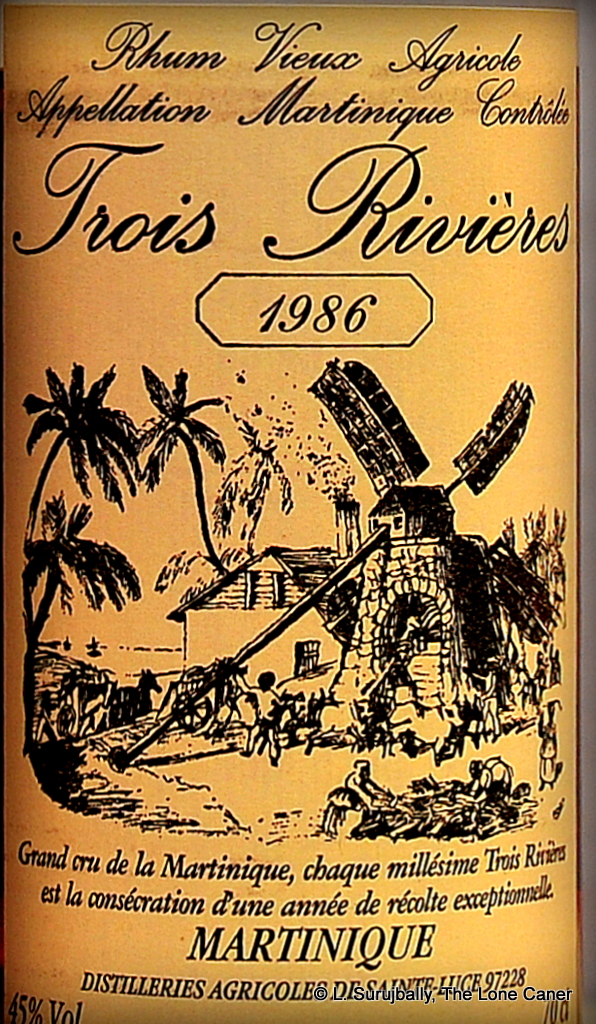
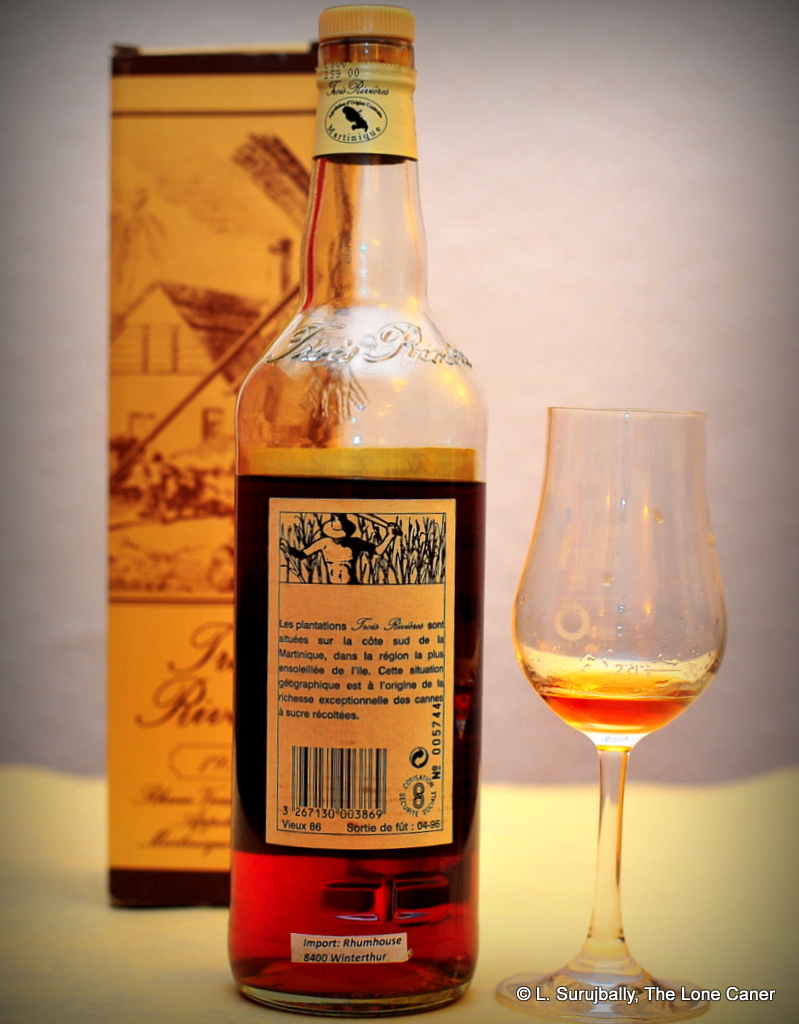
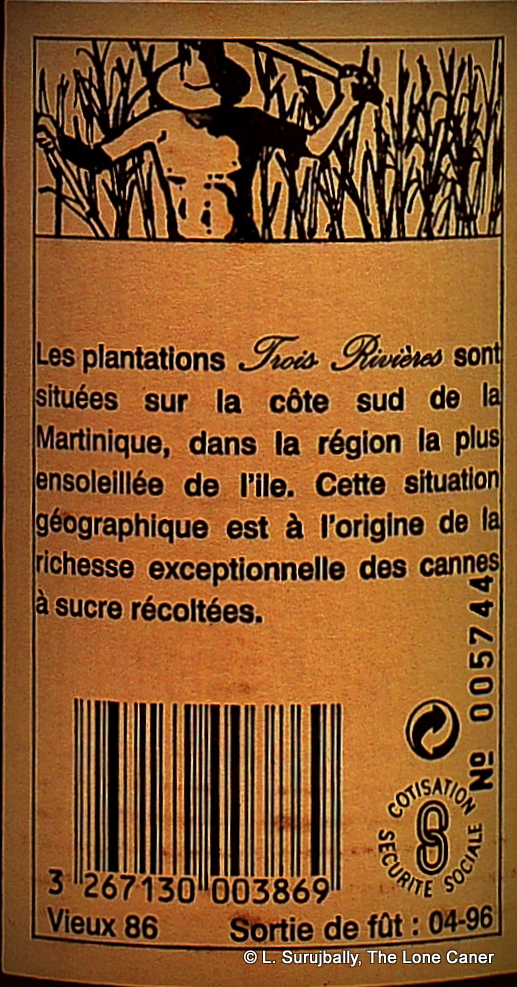 The question I asked of the 1975 (which I was using as a control alongside the Rhum Rhum Liberation Integrale, the
The question I asked of the 1975 (which I was using as a control alongside the Rhum Rhum Liberation Integrale, the 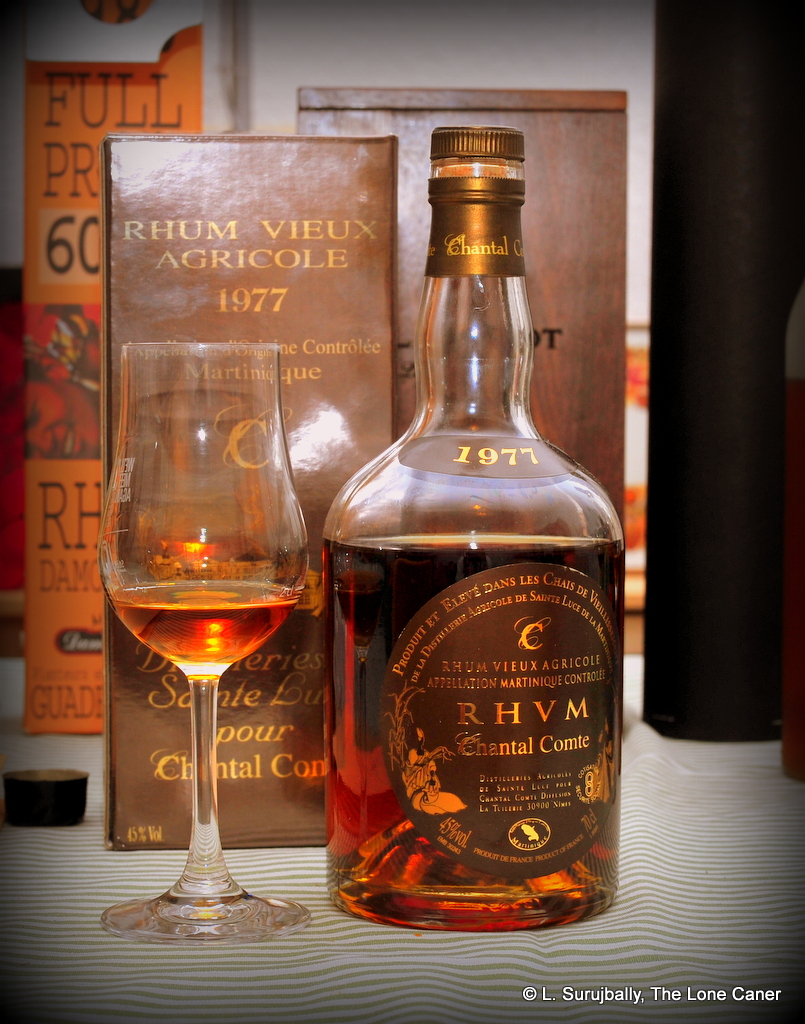
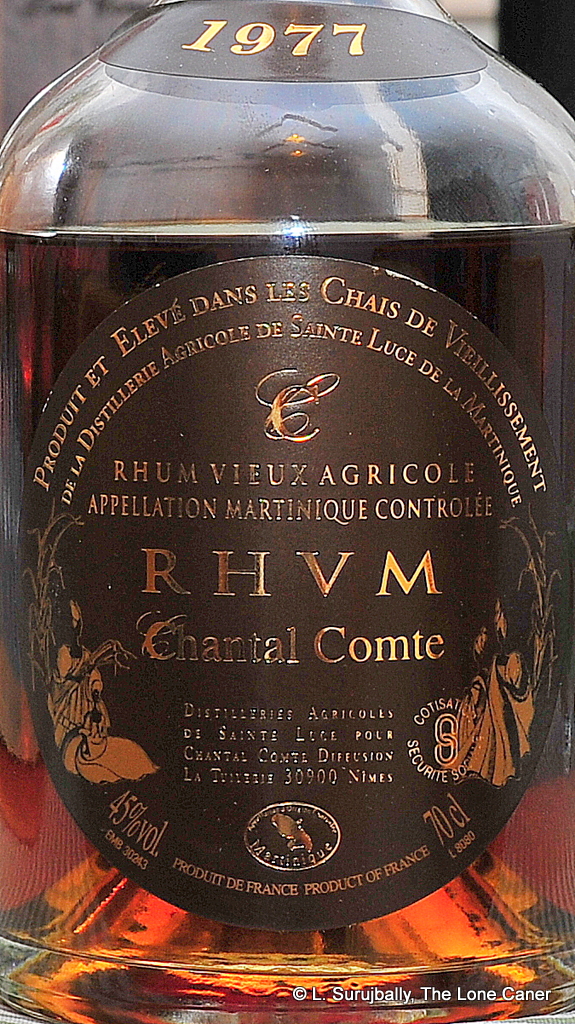 out ever letting you forget they existed. Salt beef in brine, red olives, grass, tannins, wood and faint smoke were more readily discernible, mixed in with heavier herbs like fennel and rosemary. These well balanced aromas were tied together by duskier notes of burnt sugar and vanillas and as it stood and opened up, slow scents of cream cheese and marshmallows crept out to satisfy the child within.
out ever letting you forget they existed. Salt beef in brine, red olives, grass, tannins, wood and faint smoke were more readily discernible, mixed in with heavier herbs like fennel and rosemary. These well balanced aromas were tied together by duskier notes of burnt sugar and vanillas and as it stood and opened up, slow scents of cream cheese and marshmallows crept out to satisfy the child within.